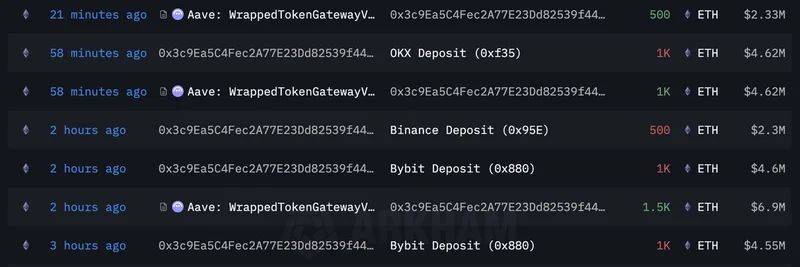Hey folks, if you've been following the wild ride of crypto markets, you've probably heard of those big players—whales—who can sway prices with their massive moves. Today, we're diving into a fresh example that's got the community buzzing: the infamous ETH whale known as "0x3c9E" has struck again, panic-dumping a whopping 5,500 ETH worth about $25.32 million. This isn't just any random trade; it's part of a pattern that's costing this whale big time, and it holds some serious lessons for anyone dabbling in meme tokens.
For those new to the lingo, a "whale" in crypto is someone holding a huge amount of a token, enough to influence the market. "Panic selling" is when fear takes over during a price dip, leading to hasty sales at low prices—only to often buy back later when things rebound, at a higher cost. On-chain analysis, like what Lookonchain provides, lets us track these moves in real-time on the blockchain.
This latest dump was highlighted in a tweet from Lookonchain on August 25, 2025. The whale sold at an average price of $4,603 per ETH over just four hours, likely amid some market jitters. But this isn't a one-off. Lookonchain has been tracking this address—full wallet: 0x3c9ea5c4fec2a77e23dd82539f4414266fe8f757—for months, and the pattern is clear: sell low, buy high.
A History of Costly Mistakes
Let's break down the timeline based on on-chain data:
Early July 2025: The whale was accumulating ETH, pulling 7,200 ETH ($18.37M) from Kraken and later buying more daily, totaling 20,300 ETH ($56.3M) deposited into DeFi platforms like Aave and Compound. These are lending protocols where users can borrow against their assets or earn interest—think of them as decentralized banks.
Early August 2025: As markets dipped, panic set in. The whale dumped 26,182 ETH ($93.66M) to exchanges like Binance, Bybit, OKX, and Kraken over 48 hours. Just a day later, another 7,500 ETH ($25.58M) followed, bringing the total sold to 33,682 ETH ($119M).
Mid-August 2025: With ETH rebounding, the whale bought back 1,800 ETH ($7.22M) at $4,010—higher than the sell price. Later, they grabbed 510,000 LINK ($11.13M) from Binance and stashed it in Compound, showing some diversification beyond ETH.
Late August 2025: History repeats. After selling 38,582 ETH ($136.9M) at $3,548 average in late July to early August, buying back 16,800 ETH ($74.3M) at $4,424, selling 10,900 ETH ($47.6M) at $4,369, and buying 7,500 ETH ($35.6M) at $4,747—just to dump again now.
You can check the full details on the whale's Arkham Intelligence profile. It's a classic case of emotional trading, amplified by leverage from DeFi. The recent transactions show withdrawals from Aave's Wrapped Token Gateway (a bridge for handling tokens in lending) before depositing to centralized exchanges, possibly to liquidate positions or cash out.
Why This Matters for Meme Token Enthusiasts
Now, you might be wondering: ETH isn't a meme token, so why care at Meme Insider? Well, meme tokens like those on Solana or Ethereum often ride the waves of major coins like ETH. When a whale dumps ETH, it can trigger broader market fear, leading to cascading sells in alts and memes. Think of it as the big fish splashing, soaking the small fry.
More importantly, this whale's antics are a textbook example of what not to do in the hyper-volatile meme token space. Meme coins thrive on hype, community, and quick flips, but they're prone to massive dumps during FUD (fear, uncertainty, doubt). If even a whale with millions is panic-selling, imagine the retail trader holding a bag of the latest dog-themed token.
Here are some key takeaways to level up your meme token game:
HODL Through the Noise: Diamond hands win. Instead of selling at the first sign of red, zoom out. Meme tokens can rebound wildly if the community stays strong.
Understand Leverage Risks: Using DeFi like Aave for borrowing can amplify gains but also losses. This whale might have been over-leveraged, forcing sells to avoid liquidation—when your collateral drops below a threshold, and the protocol sells it automatically.
Track On-Chain Signals: Tools like Lookonchain or Arkham help spot whale moves early. If you see big transfers to exchanges, it could signal incoming sells. For memes, watch for dev wallets dumping or smart money accumulating.
Diversify and Set Stops: Don't put all eggs in one basket. Use stop-loss orders to automate sells at certain levels, but avoid knee-jerk reactions.
Learn from Patterns: This isn't the first "buy high, sell low" story. Study historical data—ETH dips often precede meme token pumps as liquidity flows in.
In the end, crypto is as much about psychology as tech. This 0x3c9E saga reminds us: stay informed, stay calm, and maybe even fade the whales sometimes. If they're panic-dumping, it could be your cue to buy the dip. What's your take—ever fallen into the panic sell trap? Drop your stories in the comments, and keep building that knowledge base here at Meme Insider.
For more on-chain insights and meme token deep dives, stick around or check out our latest on top meme tokens to watch.

